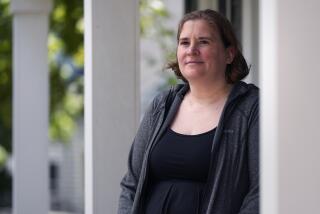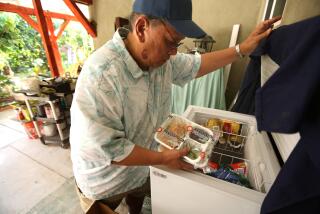Summer Lunch Plan Lags in Some Counties
Last summer, Covina Park bustled with the energy of children eating free lunches courtesy of a federal program designed to provide low-income youngsters with a nutritious meal during vacation.
This year, the park is quiet, the food program dropped because of a budget crunch and doubt that federal reimbursements would cover the costs.
In Compton, where children received free summer lunches last year, alternatives are being sought, after several community groups opted not to sponsor the lunches because of complex rules and onerous paperwork.
The Covina and Compton cases are not isolated. Nationally and in California, the summer nutrition program is struggling, plagued by the loss of sponsors and inability to meet the needs of millions of eligible children. The program is the largest federal effort to feed low-income children during the summer.
The nutrition programs in Ventura County have, so far, avoided this downturn. Billie Hayes, who co-coordinates the summer free lunch program sponsored by the Ventura Unified School District, said there had been no cutbacks this year in this county, where about 2,000 meals are served each weekday.
“I know some of the kids would not be eating lunch if it wasn’t for this program,” said Patti Birmingham, director of operations for the Boys & Girls Club of Ventura, one of 26 lunch sites in Ventura County. Summer lunch programs at local school sites ended Friday, but 10 others will continue through Aug. 16.
In 2001, the number of sponsors for summer nutrition programs in California declined by 6%, according to recent studies. That reflected a national trend in which 47,000 fewer children--a decline of 2.3% from the year before--received the summer meals.
Advocates said the decrease appears to be continuing this year. In addition to the loss of sponsors they blame the public’s spotty awareness of the meals.
Matt Sharpe, regional director of the California Food Policy Advocates, a group that works to ease hunger, recalled his efforts to enlist six Los Angeles-area churches to sponsor new feeding sites this year. All chose not to.
“Some said it was too much government hassle, too much paperwork,” he said. “Some said they hadn’t realized how many children they would have to feed to break even.”
Some counties in California lost more ground last year than others, according to a recent survey by the Food Policy Advocates. In Ventura County the number of sites serving free lunches dropped to three in 2001 from 20 the year before. The number of sites in Los Angeles serving food declined to 616 from 656. Orange County maintained most of its centers, replacing sponsors that dropped out.
“For kids on summer recess in these areas, not having access to the summer lunch program puts their families in a difficult position,” said Michael Flood, executive director of the Los Angeles Regional Food Bank. “For many, the only other option is charitable food from a pantry.”
In 1968, Congress initiated summer lunches as a pilot program, which was extended nationwide in 1975. School districts, nonprofit agencies, universities, and city, county and Native American tribal governments can be sponsors.
Many sites also provide recreational and educational activities. The sponsors can prepare their own meals or pay for food preparation and be reimbursed by the U.S Department of Agriculture according to a complex set of guidelines.
But advocates say those guidelines--some designed to prevent fraud--pose barriers for potential sponsors. In addition, Congress, in overhauling welfare laws, cut reimbursement rates and eliminated some start-up funds.
The city of Covina dropped its one summer meal site this year after anticipating that it would not be able to pay $4,000 for staffing, said recreation services supervisor Carren Chaney. For example, sponsors have to make sure that parents don’t eat food meant for kids.
Keith Rodgers, who helps to direct a city-run day camp at a Compton park, said the summer lunch program attracted many families. But after it was dropped by its church sponsor a year ago, some families now go to charitable food giveaways.
The city of Los Angeles’ Parks and Recreation Department operates 100 summer lunch sites. About 25% of the $1.6 million spent on the program last year--mostly for staffing-- was picked up by taxpayers, said manager Vicki Israel.
“The truth is if the mayor and City Council did not support the program we’d have to reduce or cancel it,” she said. “Maybe the USDA needs to provide more money per meal. The funding we get has remained constant but cost of caterers, transportation, gasoline all keeps going up.”
Israel cited the example of one caterer who ran out of 100% fruit juice drinks and had to deliver 80% juice instead. Because of strict rules, the city was not reimbursed for the juice, she said.
The growth of year-round schools in Los Angeles and other cities has further complicated matters. While more youngsters are in school during summer and get free lunches there, most of those school-based programs will not serve neighborhood children on vacation. Los Angeles officials have set up 34 sites to serve lunches year round, but Israel said twice as many are needed.
In California last year, 37% of the 1.8 million children who received a free school lunch participated in the summer program, according to the state Department of Education. California’s rate ranks among the top three, according to a national survey by the Food Research and Action Center. But advocates say there is still much unmet need.
Lawmakers and advocates are looking at ways to keep the program going and increase participation. In California this year, the USDA made it easier for school districts serving school lunches to provide summer lunches. Sen. Dick Luger (R-Indiana) last month introduced legislation to help ease paperwork and increase reimbursements.
*
Times staff writer Amanda Covarrubias contributed to this report.
More to Read
Sign up for Essential California
The most important California stories and recommendations in your inbox every morning.
You may occasionally receive promotional content from the Los Angeles Times.











